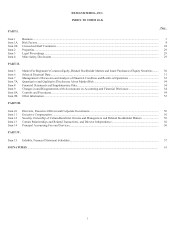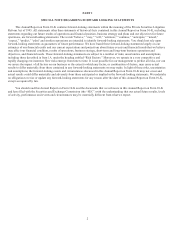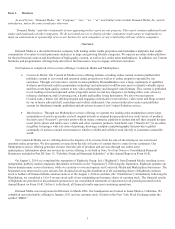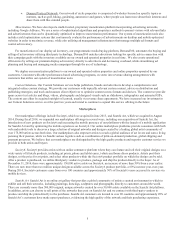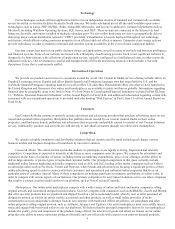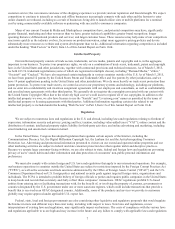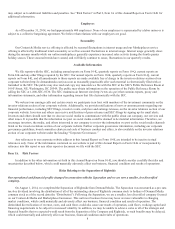Enom 2014 Annual Report Download - page 14
Download and view the complete annual report
Please find page 14 of the 2014 Enom annual report below. You can navigate through the pages in the report by either clicking on the pages listed below, or by using the keyword search tool below to find specific information within the annual report.11
the services that Google provides to us, or a loss of revenue generated by our advertising agreement with Google, would have a
material adverse effect on our business, financial condition and results of operations.
We generate the majority of our revenue from advertising. A reduction in ad unit rates, online advertising spend, a loss of
advertisers or lower advertising yields could seriously harm our business, financial condition and results of operations.
We rely on third-party advertising providers, such as Google, to provide advertisements to our owned and operated online
properties and our customers’ online properties. For the years ended December 31, 2014, 2013 and 2012, after giving effect to the
Separation, we generated 70%, 83% and 83%, respectively, of our revenue from advertising, and we expect to continue to derive the
majority of our revenue from advertising. We have experienced declines in ad unit rates for both desktop and mobile during 2014,
resulting in lower advertising revenue, and any further reductions in ad unit rates would negatively impact our financial results. We
also believe that advertising spend on the Internet, as in traditional media, fluctuates significantly as a result of a variety of factors,
many of which are outside of our control. These factors include variations in expenditures by advertisers due to budgetary constraints;
the cyclical and discretionary nature of advertising spending; general economic conditions, as well as economic conditions specific to
the Internet and media industry; and the occurrence of extraordinary events, such as natural disasters, international or domestic
terrorist attacks or armed conflict. Additionally, brands and advertisers are increasingly focusing a portion of their online advertising
budgets on social media outlets such as Facebook, Twitter and Pinterest. If this trend continues and we are unable to offer competitive
or similarly valued advertising opportunities, our revenue from advertising could be adversely impacted. An inability to maintain or
increase our advertising revenue would have a material adverse effect on our business, financial condition and results of operations.
In 2014, we shifted our advertising strategy with respect to our display ad inventory to focus on programmatic offerings that
utilize advertising network exchanges rather than a direct sales force. This shift requires us to actively manage the sale of our owned
and operated inventory on an advertising exchange. An inability to successfully manage this process could have a material adverse
effect on our business, financial condition and results of operations.
In addition, one component of our platform that we use to generate advertiser interest is our system of monetization tools, which
is designed to match content with advertisements in a manner that optimizes revenue yield and end-user experience. Advertising
providers and advertisers will stop placing advertisements on our owned and operated online properties or our customers’ online
properties if their investments do not generate sales leads, and ultimately customers, or if we do not deliver their advertisements in an
appropriate and effective manner. The failure of our yield-optimized monetization technology to effectively match advertisements
with our content in a manner that results in increased revenue for advertisers would have an adverse impact on our ability to maintain
or increase our revenue from advertising. If any of our advertisers or advertising providers, and in particular Google, decides not to
continue advertising on, or providing advertisements to, our owned and operated online properties or our customers’ online properties,
or modifies its advertising policies in a manner that could negatively impact yield, we could experience a rapid decline in our revenue
over a relatively short period of time.
Changes in our Content & Media business model and increased expenditures for certain aspects of this business, including
planned improvements to certain of our online properties, will negatively impact our operating margins in the near-term and may
not lead to increased visits and revenue in the long-term.
We have incurred and intend to continue to incur significant expenses to improve the user experience and engagement on certain of
our owned and operated online properties by redesigning our websites; refining and consolidating our existing content library; reducing
the number of advertisements per page; and developing a greater variety of content formats, particularly formats better suited for mobile
devices. Such expenses do not directly generate related revenue and could lead to reduced revenue, and these changes will negatively
impact our operating margins in the near-term. These changes also may not result in increased visits to, or increased revenue generated
by, our owned and operated online properties in the long-term. In addition, we recorded approximately $7.2 million of accelerated
amortization expense during the year ended December 31, 2014 and are likely to record a significant amount of accelerated amortization
expense during fiscal 2015 in connection with removing additional content from our library. As a result of previous evaluations of our
content library, we elected to remove certain articles, videos and slideshows, resulting in related accelerated amortization expense of $2.4
million, $2.1 million and $5.9 million for the years ended December 31, 2013, 2012 and 2011, respectively.
In addition, we plan to continue to expand our investment in our Content Solutions offering, which helps publishers and brands
broaden their reach online by providing them with topically relevant custom content, spanning across text, video, photography and
designed visuals, to publish on their online properties or for use in other distribution outlets. If our existing and prospective Content
Solutions customers do not perceive our content to be driving performance for their business, we may not be able to expand our
relationship with our current customers or identify and attract new customers, and we may not generate sufficient revenue through this
service offering to justify our current investment in this business.


